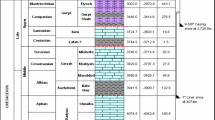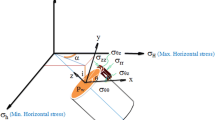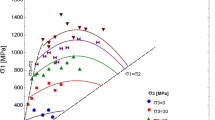Abstract
Drilling mud weight and wellbore orientation are convenient factors to manage wellbore stability. Improper selection of these convenient parameters causes the formation break-out or drilling-induced fracture. The main objective of this study is, to predict the optimum drilling mud weight with the concept of a new 3D failure criterion and drilling-exponent (D-exponent) factor for the proper maintenance of wellbore stability in challenging environments. The new failure criterion is derived as the function of principal stresses acting on the in situ rock. To prevent the formation break-out, optimum mud weight is calculated by the proposed criterion. Stresses around the wellbore acted in the cylindrical coordinate, so the kirsch equation converted all orthogonal stress into the cylindrical coordinate. A theoretical model calculates optimum mud weight by the proposed failure criterion and existing criteria like the Mohr-Coulomb criterion and the Mogi-Coulomb criterion. The D-exponent factor further corrects this suggested mud weight by real-time monitoring the drilling event. Mohr-Coulomb failure criterion overestimates the formation's strength as the criterion neglects the intermediated principal stress. Mogi-Coulomb criterion gave a dual result for optimum mud weight due to the quadratic equation of octahedral shear stress. Optimum mud weight prediction by the above methods is comparatively less accurate than our proposed model. The proposed criterion considers the effect of intermediate principal stress as a linear function of all stresses that make the mathematical model more effective and reliable for real problems. The predicted mud weight is updated in real-time monitoring by the D-exponent factor considering the drilling parameters like penetration rate (ROP) and tool cutting speed (RPM), weight on bit, and borehole diameter. This proposed model is also recommended for exploratory wells to predict and implement drilling parameters to maintain wellbore stability. The proposed new 3D failure criterion is an extended form of the Mohr-Coulomb criterion, where the roles of intermediate stress are also considered to predict optimum mud weight to keep the wellbore stable in a challenging environment. The proposed model is further helpful for maintaining wellbore stability in the exploratory well in high-pressure and high-temperature well, and environmentally challenged well by real-time monitoring.
Access this chapter
Tax calculation will be finalised at checkout
Purchases are for personal use only
Similar content being viewed by others
References
Al-Ajmi, A. M., & Zimmerman, R. W. (2005). Relation between the Mogi and the Coulomb failure criteria. International Journal of Rock Mechanics and Mining Sciences, 42(3), 431–439.
Das, B., & Chatterjee, R. (2017). Wellbore stability analysis and prediction of minimum mud weight for few wells in Krishna-Godavari Basin, India. International Journal of Rock Mechanics and Mining Sciences, 93, 30–37.
Eaton, B. A. (1975). The equation for geopressure prediction from well logs. Fall Meeting of the Society of Petroleum Engineers of AIME.
Mahetaji, M., & Brahma, J. (2023). Prediction of minimum mud weight for prevention of breakout using new 3D failure criterion to maintain wellbore stability. Rock Mechanics and Rock Engineering, 1–22.
Mahetaji, M., Brahma, J., & Vij, R. K. (2023). A new extended Mohr-Coulomb criterion in the space of three-dimensional stresses on the in-situ rock. Geomechanics Engineering, 32, 49–68.
Maleki, S., Gholami, R., Rasouli, V., Moradzadeh, A., Riabi, R. G., & Sadaghzadeh, F. (2014). Comparison of different failure criteria in prediction of safe mud weigh window in drilling practice. Earth-Science Reviews, 136, 36–58.
Ulusay, R. (Ed.). (2015). The ISRM suggested methods for rock characterization, testing and monitoring: 2007–2014. Springer.
Van Adrichem Boogaert, H. A., & Kouwe, W. P. F. (1993). Stratigraphic nomenclature of the Netherlands, revision and update by RGD and NOGEPA.
Author information
Authors and Affiliations
Corresponding author
Editor information
Editors and Affiliations
Rights and permissions
Copyright information
© 2024 The Author(s), under exclusive license to Springer Nature Switzerland AG
About this paper
Cite this paper
Mahetaji, M., Brahma, J., Vij, R.K. (2024). Real-Time Optimum Drilling Mud Weight Prediction by New 3D Criterion to Manage Wellbore Stability in Challenging Environments. In: Bezzeghoud, M., et al. Recent Research on Geotechnical Engineering, Remote Sensing, Geophysics and Earthquake Seismology. MedGU 2022. Advances in Science, Technology & Innovation. Springer, Cham. https://doi.org/10.1007/978-3-031-48715-6_54
Download citation
DOI: https://doi.org/10.1007/978-3-031-48715-6_54
Published:
Publisher Name: Springer, Cham
Print ISBN: 978-3-031-48714-9
Online ISBN: 978-3-031-48715-6
eBook Packages: Earth and Environmental ScienceEarth and Environmental Science (R0)




